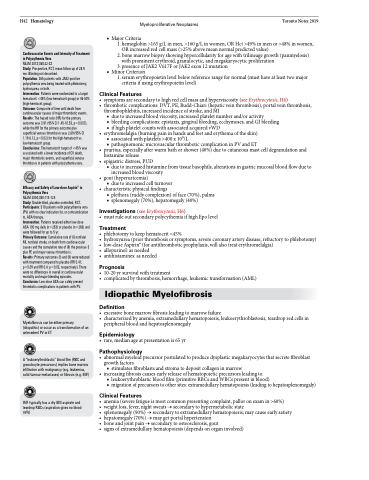Page 582 - TNFlipTest
P. 582
H42 Hematology
Myeloproliferative Neoplasms Toronto Notes 2019
■ Major Criteria
1. hemoglobin >165 g/L in men, >160 g/L in women, OR Hct >49% in men or >48% in women,
OR increased red cell mass (>25% above mean normal predicted value)
2. bone marrow biopsy showing hypercellularity for age with trilineage growth (panmyelosis)
with prominent erythroid, granulocytic, and megakaryocytic proliferation 3. presence of JAK2 V617F or JAK2 exon 12 mutation
■ Minor Criterion
1. serum erythropoietin level below reference range for normal (must have at least two major
criteria if using erythropoietin level)
Clinical Features
• symptomsaresecondarytohighredcellmassandhyperviscosity(seeErythrocytosis,H6)
• thromboticcomplications:DVT,PE,Budd-Chiari(hepaticveinthrombosis),portalveinthrombosis,
thrombophlebitis, increased incidence of stroke, and MI
■ due to increased blood viscosity, increased platelet number and/or activity
■ bleeding complications: epistaxis, gingival bleeding, ecchymoses, and GI bleeding ■ if high platelet counts with associated acquired vWD
• erythromelalgia (burning pain in hands and feet and erythema of the skin) ■ associated with platelets >400 x 109/L
■ pathognomonic microvascular thrombotic complication in PV and ET
• pruritus,especiallyafterwarmbathorshower(40%)duetocutaneousmastcelldegranulationand histamine release
• epigastricdistress,PUD
■ due to increased histamine from tissue basophils, alterations in gastric mucosal blood flow due to
increased blood viscosity • gout(hyperuricemia)
■ due to increased cell turnover • characteristicphysicalfindings
■ plethora (ruddy complexion) of face (70%), palms ■ splenomegaly (70%), hepatomegaly (40%)
Investigations (see Erythrocytosis, H6)
• must rule out secondary polycythemia if high Epo level
Treatment
• phlebotomytokeephematocrit<45%
• hydroxyurea(priorthrombosisorsymptoms,severecoronaryarterydisease,refractorytophlebotomy) • low-doseAspirin®(forantithromboticprophylaxis,willalsotreaterythromelalgia)
• allopurinol:asneeded
• antihistamines: as needed
Prognosis
• 10-20yrsurvivalwithtreatment
• complicatedbythrombosis,hemorrhage,leukemictransformation(AML)
Idiopathic Myelofibrosis
Definition
• excessivebonemarrowfibrosisleadingtomarrowfailure
• characterizedbyanemia,extramedullaryhematopoiesis,leukoerythroblastosis,teardropredcellsin
peripheral blood and hepatosplenomegaly
Epidemiology
• rare,medianageatpresentationis65yr
Pathophysiology
• abnormalmyeloidprecursorpostulatedtoproducedysplasticmegakaryocytesthatsecretefibroblast growth factors
■ stimulates fibroblasts and stroma to deposit collagen in marrow
• increasing fibrosis causes early release of hematopoietic precursors leading to:
■ leukoerythroblastic blood film (primitive RBCs and WBCs present in blood)
■ migrationofprecursorstoothersites:extramedullaryhematopoiesis(leadingtohepatosplenomegaly)
Clinical Features
• anemia(severefatigueismostcommonpresentingcomplaint,palloronexamin>60%)
• weight loss, fever, night sweats → secondary to hypermetabolic state
• splenomegaly (90%) → secondary to extramedullary hematopoiesis; may cause early satiety • hepatomegaly(70%)→maygetportalhypertension
• boneandjointpain→secondarytoosteosclerosis,gout
• signsofextramedullaryhematopoiesis(dependsonorganinvolved)
Cardiovascular Events and Intensity of Treatment in Polycythemia Vera
NEJM 2013;368:22-33
Study: Prospective, RCT, mean follow-up of 28.9 mo. Blinding not described.
Population: 365 patients with JAK2-positive polycythemia vera being treated with phlebotomy, hydroxyurea, or both.
Intervention: Patients were randomized to a target hematocrit <45% (low-hematocrit group) or 45-50% (high-hemtocrit group).
Outcome: Composite of time until death from cardiovascular causes of major thrombotic events. Results: The hazard ratio (HR) for the primary outcome was 3.91 (95% CI 1.45-10.53, p=0.007), while the HR for the primary outcome plus superficial venous thrombosis was 2.69 (95% Cl 1.19-6.12, p=0.02) for the high-hematocrit vs. low-hematocrit group.
Conclusions: The hematocrit target of <45% was associated with a lower incidence of CV death, major thrombotic events, and superficial venous thrombosis in patients with polycythemia vera.
Efficacy and Safety of Low-dose Aspirin® in Polycythemia Vera
NEJM 2004;350:114-124
Study: Double-blind, placebo-controlled, RCT. Participants: 518 patients with polycythemia vera (PV) with no clear indication for, or contraindication to, ASA therapy.
Intervention: Patients received either low-dose ASA 100 mg daily (n=253) or placebo (n=265) and were followed for up to 5 yr.
Primary Outcome: Cumulative rate of (I) nonfatal MI, nonfatal stroke, or death from cardiovascular causes and the cumulative rate of (II) the previous 3 plus PE and major venous thrombosis.
Results: Primary outcomes (I) and (II) were reduced with treatment compared to placebo (RR 0.41; p=0.09 and RR 0.4; p=0.03, respectively). There were no differences in overall or cardiovascular mortality and major bleeding episodes.
Conclusion: Low-dose ASA can safely prevent thrombotic complications in patients with PV.
Myelofibrosis can be either primary (idiopathic) or occur as a transformation of an antecedent PV or ET
A “leukoerythroblastic” blood film (RBC and granulocyte precursors) implies bone marrow infiltration with malignancy (e.g. leukemias, solid tumour metastases) or fibrosis (e.g. IMF)
IMF typically has a dry BM aspirate and teardrop RBCs (aspiration gives no blood cells)


